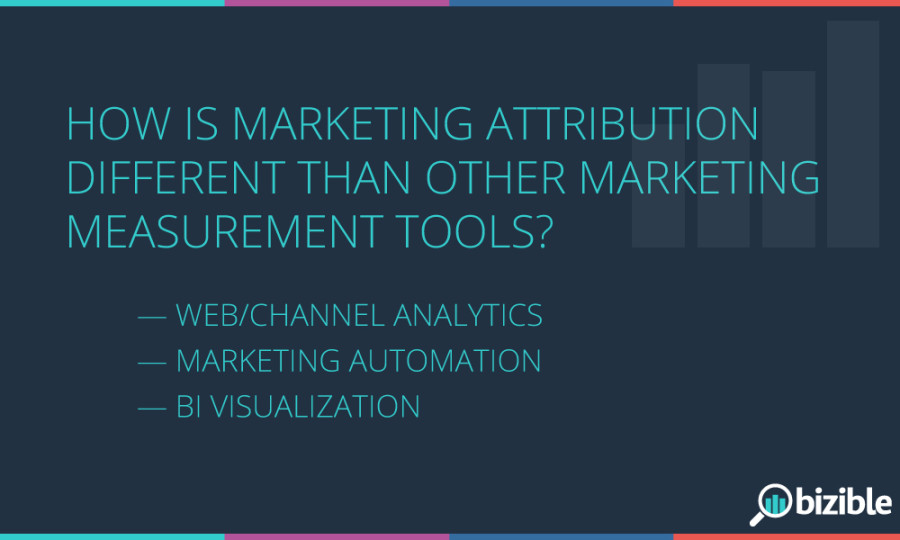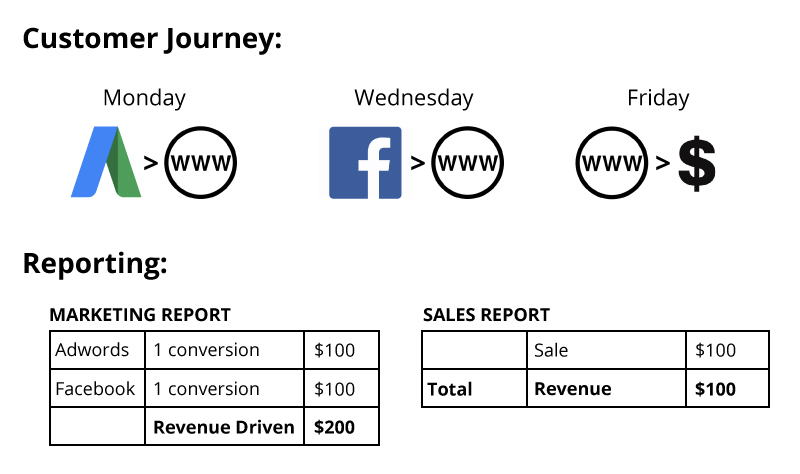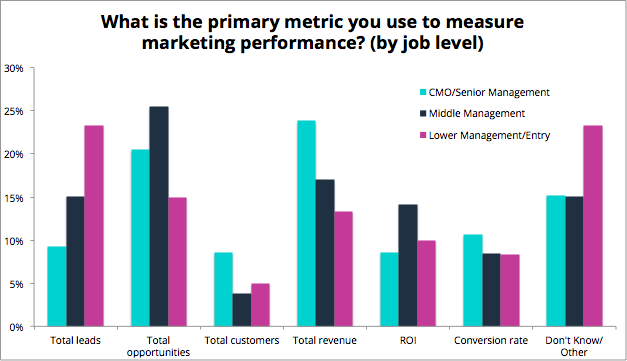Many marketing tools — ones that most B2B organizations already use — claim to do attribution, or at least some version of it. For CMOs, it’s natural to want to use these tools for attribution as well, since they’ve already committed to the rest of the tool. But unfortunately, when you take a closer look, you will see that they don’t really do what you need and you will end up with the same problems you were trying to solve with attribution in the first place.
Web and Other Channel-Specific Analytics — “Hacking” an Attribution System
It’s a common belief that marketers can hack together an attribution system themselves, using a combination of web and channel analytics, plus some Excel expertise. If you’re spending hundreds or maybe a couple thousand on paid advertising a month, then hacking something satisfactory is probably achievable. However, if you’re investing any significant amount, a hacked solution will not suffice.
When it comes to attribution, web analytics (e.g. Google Analytics) and channel-specific analytics (e.g. Facebook Insights) are limited in that the furthest down the funnel they track is form conversions. In a B2B situation, form conversions are still just a proxy for revenue — a pretty distant one, too. It’s not bad for a free or inexpensive tool, but even after quite a bit of work to create a usable attribution solution — meticulous use of UTM parameters, event setting, and connecting spreadsheets full of channel-specific data in order to dig into the necessary granularity of each channel all the way through to revenue — there’s still the problem of decentralization.
Because the attribution is done by each marketing channel separately (decentralized), marketers face the challenge of double-counting credit. For example, if a visitor clicks on an AdWords ad on Monday, a Facebook ad on Wednesday, and then buys something for $100 on Friday, both your AdWords data and your Facebook data will claim 100% conversion credit. That’s because they don’t communicate with each other. When you bring both data sources into your spreadsheet and enter in that the conversion was worth $100, your report will show $200 of revenue — 2x your actual revenue — a big, and potentially embarrassing, problem.
Marketing Automation
Another set of marketing tech, marketing automation (e.g. Marketo, Eloqua, Pardot, Hubspot), focuses on lead creation and typically looks at attribution measurement from a broad channel or campaign perspective. They are great at telling marketers what channels impact the middle of the funnel (lead creation), but they don’t do a good job looking at bottom-of-the-funnel metrics (sales opportunities and revenue) with granularity needed for optimization, such as by paid search keywords, by specific blog posts, or by which events were contributing as the source.
Because they are so focused on lead creation, they also do a poor job with the top of the marketing funnel. Marketing automation tools don’t connect back to the first anonymous touch, which is vital in understanding the start of the customer journey. Without that first touch, would the visitor have come back to request a demo?
Without the initial step in the funnel or the bottom-of-the-funnel metrics, marketing automation doesn’t fulfill the multi-touch attribution needs of most B2B marketing teams.
Moreover, their tracking is often inadequate to capture the full B2B customer journey. (This is also true of most channel-specific analytics.) Most have cookies that expire within 30-90 days of the contact creation date. It’s fine for B2C marketers (and built with them in mind), where the decision process ranges from hours to a few weeks, but as B2B marketers know, the B2B customer journey is often longer than 90 days.
You don’t use marketing automation for web analytics, SEO, or advanced A/B testing, so why would you for something as critical as revenue attribution?
Business Intelligence Visualization Tools
Business intelligence tools (e.g. Tableau, DOMO, Qlik) are designed to help marketers visualize lots of data at a time, and they do just that. However, because they don’t actually create data (e.g. use cookies to track visitor behavior and marketing activities) they are only as useful as the data that is inputted, which means you’ll still have to hack together data from several sources that aren’t designed to work together. You’ll also run into the same limitations as the other marketing tools because you are relying on their data. For example, if the source data only tracks visitors to form conversion, business intelligence tools won’t help you past that.
The Biggest Difference Is…
Finally, the biggest limitation of all of these marketing tools is that they don’t connect into a CRM. Because of that, they can’t connect to specific customers and therefore doesn’t connect to the sales department and revenue. This is often serviceable for B2C attribution because there isn’t a sales team process, but it doesn’t cut it for B2B attribution.
In the 2015 State of Pipeline Marketing Report, CMOs disproportionately reported using total revenue as the primary metric to measure marketing performance, while less experienced marketers reported that they use higher funnel metrics, like leads. Essentially, the more senior the marketer, the more important the bottom-of-the-funnel metrics are.
However, that also means that while CMOs may think their primary metric is revenue, their team is using other metrics, and that may be because they don’t have the right tools — only 21% of non-CMO level marketers believe they are using the right attribution model. To find out why the team is focusing on top and middle-of-the-funnel metrics, CMOs should ask them questions like:
- What was last month’s revenue by AdWords keyword by first (anonymous) touch?
- What multi-touch attribution model are we using? W-shaped?
- Why are we using our current attribution model?
- Does our attribution model include first (anonymous) visitors? How about accounting for account based marketing?
- Do we look at digital channels such as paid social and offline channels such as events/conferences with the same attribution model?
- What metric(s) does it help optimize for?
CMOs might be measured based on revenue, but if their team is optimizing for other metrics (e.g. leads), the marketing will be misaligned and will underperform.
For B2B marketers to accurately report on these bottom-of-the-funnel metrics, it is absolutely necessary for the attribution solution to seamlessly integrate with the CRM.
While many tools claim to do attribution, if you really look into it and ask the right questions, you’ll find that they don’t fit the bill. To learn more about attribution, as well as what you should be looking for in an attribution tool, check out The CMO’s Guide to B2B Marketing Attribution.




